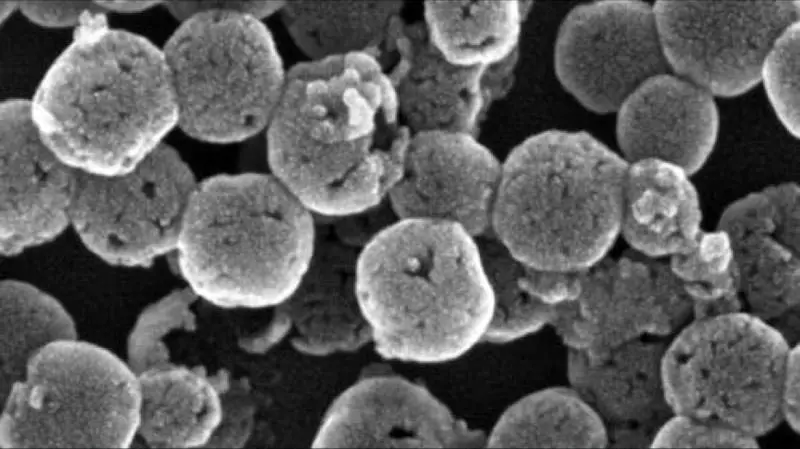The University of Notre Dame research team, under the leadership of Professor Bradley Smith, has fortuitously discovered an innovative method to boost the efficacy of existing drugs. This is achieved by encapsulating the drugs in modified silica particles, as elaborated in the journal Nanoscale. Credit: Nanoscale, 2022, DOI: 10.1039/D2NR05528G, Royal Society of Chemistry
Researchers from the University of Notre Dame have unveiled a cost-effective approach to enhance drug effectiveness by encapsulating them within thermally-altered silica particles. These manipulated particles possess the ability to retain and control the release of chemicals, thereby paving the way for optimized drug delivery systems and novel insights into biomineralization.
This newly found technique, published in Nanoscale, presents a cost-effective strategy to increase the potency of existing drugs.
Bradley Smith, the Emil T. Hofman Professor of Science at the University of Notre Dame, explains, “When you heat sand to 500 degrees Celsius, nothing changes.” Smith, who also heads Notre Dame’s Integrated Imaging Facility, was taken aback when two PhD students, Canjia Zhai and Cassandra Shaffer, under his tutelage, found they could alter the structure of silica particles at a temperature of around 80 degrees Celsius, akin to a cup of coffee’s warmth.
This discovery was entirely serendipitous. The involved particles were microscopic, a thousandth the size of a human hair. Similar to the silica gel found in new clothing items, these particles were porous and could retain a chemical. In this case, the chemical was a blue dye used for tumor detection in mice.
In an effort to expedite the diffusion of the newly-developed dye into the narrow particle pores, Shaffer and Zhai heated the mixture just short of boiling and left it overnight. The next day, the particles were visibly blue, indicating the dye infusion.
To verify the complete infusion, the team brought in Tatyana Orlova and Maksym Zhukovskyi, microscopy experts from Notre Dame’s Integrated Imaging Facility. High-resolution electron microscopy images confirmed the dye infusion and also revealed a surprising alteration in the shape of the silica particles. Initially, the particles were solitary spheres with a sparse sprinkling of pores. The new structures were composed of smaller dye-filled globules with a few openings leading to a hollow core inside, resembling a hollow raspberry.
Following this startling discovery, practical queries ensued: What other chemicals could be loaded into these raspberry-like particles? Would the chemicals maintain their activity even after the structural transformation?
PhD candidate Jordan Chasteen undertook the task of addressing these questions, repeating the process using a cancer drug. After a series of tests, he confirmed that the cancer drug, loaded into the particles, retained its activity and was able to kill cancer cells.
According to Smith, this breakthrough provides a new instrument for enhancing the effectiveness of existing drugs.
“This gives us the opportunity to revisit the entire catalog of amine-containing drugs. By following the steps we have unearthed, we can generate new versions of existing drugs that could be more effective or reduce unwanted side effects,” he stated.
The team has discovered that subtle alterations in the loading process could lead to variable thickness in the particles. This offers a multitude of new possibilities for fine-tuning the particles to release drugs at varying rates. The unique structure of the new particle might also enable dual-loading, like a drug in the outer layer and a dye inside the “raspberry”, to further study drug release mechanisms.
Moreover, Smith said, this new particle contributes to a better understanding of the largely obscure biological process called biomineralization.
“We have learned that amine-containing drugs
Table of Contents
Frequently Asked Questions (FAQs) about Drug Delivery Enhancement
What was the unexpected discovery made at the University of Notre Dame?
The research team at the University of Notre Dame, led by Professor Bradley Smith, discovered a low-cost method to increase the effectiveness of existing drugs. This was achieved by loading the drugs into thermally-modified silica particles. The discovery was accidental but has significant potential implications for drug delivery systems and our understanding of biomineralization.
Who was involved in this discovery?
The discovery involved several researchers and doctoral students from the University of Notre Dame. The team was led by Professor Bradley Smith, the Emil T. Hofman Professor of Science at the university. Two doctoral students, Canjia Zhai and Cassandra Shaffer, made the initial discovery. Another doctoral student, Jordan Chasteen, further validated the findings. Microscopy experts Tatyana Orlova and Maksym Zhukovskyi also contributed by verifying the findings.
What does this discovery mean for existing drugs?
The discovery provides a new method to make existing drugs more effective. By encapsulating drugs within these thermally-altered silica particles, the drugs’ potency can be enhanced. The unique structure of the modified particles could also potentially allow for dual-loading, increasing researchers’ ability to study drug release mechanisms.
What is the relevance of this discovery to biomineralization?
Biomineralization is a biological process in which organisms form inorganic materials. The discovery made by the Notre Dame team has shed light on how amine-containing drugs can speed up the degradation and reforming process in silica, which could be similar to what occurs in natural biomineralization. This could lead to better understanding of how organisms like diatoms, a type of microscopic plankton, form their delicate glass-like shells from silica.
Where can I find more details about this research?
This research was detailed in a paper titled “Silica nanoparticle remodeling under mild conditions: versatile one-step conversion of mesoporous to hollow nanoparticles with simultaneous payload loading,” published in the journal Nanoscale on 21 November 2022. The DOI is 10.1039/D2NR05528G.
More about Drug Delivery Enhancement
- Notre Dame University
- Nanoscale Journal
- Overview of Biomineralization
- National Science Foundation
- National Institutes of Health


